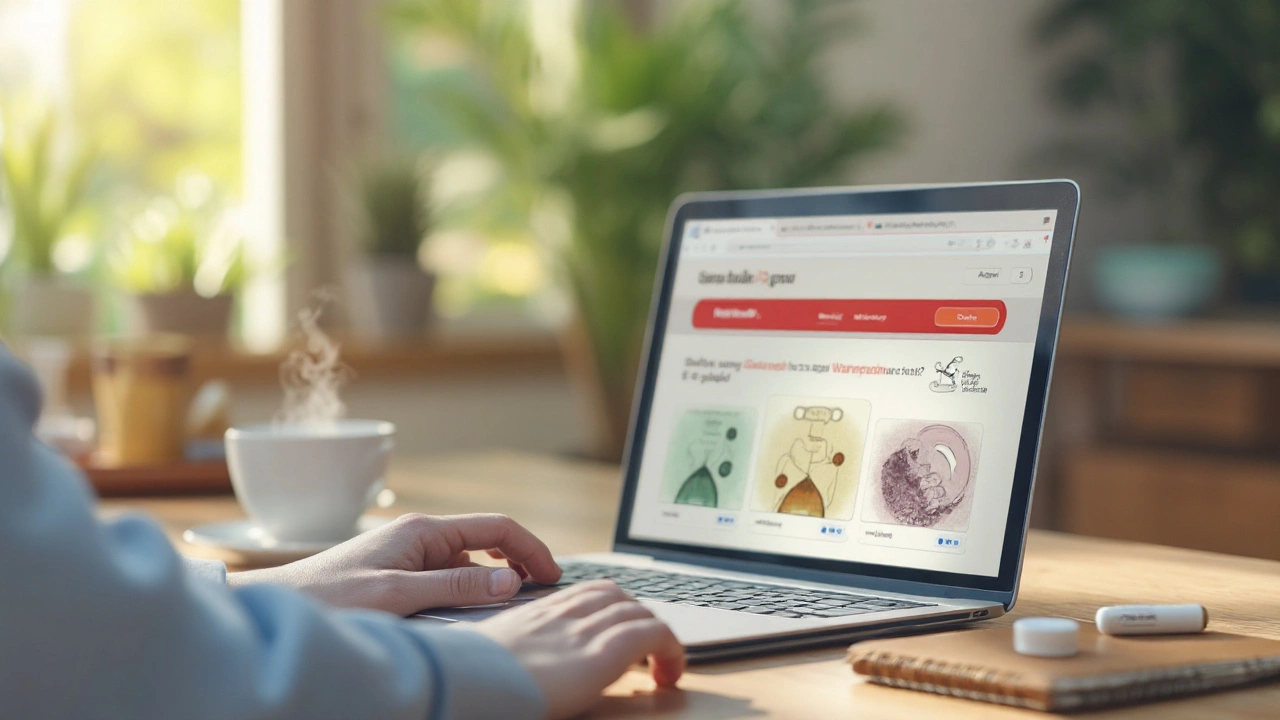Generic warfarin is a synthetic oral anticoagulant used to prevent blood clots. It works by inhibiting vitamin K‑dependent clotting factors, keeping the blood from thickening too much. Because the active molecule is the same as the brand‑name version, it costs a fraction of the price, making it a popular choice for long‑term therapy.
Why People Look for Cheap Generic Warfarin
Living with a condition that needs a blood thinner can be expensive. The UK’s National Health Service (NHS) provides prescriptions free at the point of use, but not everyone qualifies for full coverage. Many patients turn to private prescriptions or online sources to keep monthly costs under £10. A lower price tag doesn’t automatically mean lower quality - the key is finding a reputable supplier that follows strict regulations.
Anticoagulant is a class of drugs that includes warfarin, dabigatran, and rivaroxaban. Warfarin remains the most prescribed oral anticoagulant in the UK because doctors have decades of experience managing its dose through INR monitoring.
Legal Landscape: Who Regulates Online Sales?
In the UK, the MHRA (Medicines and Healthcare products Regulatory Agency) oversees the safety of medicines sold online. Any pharmacy that ships to British addresses must hold a valid MHRA licence and appear on the official “Registered Online Pharmacies” list. In the US, the FDA (Food and Drug Administration) plays a similar role.
When you search for cheap generic warfarin, look for URLs that end in ".co.uk" and display the MHRA registration number. Those sites are audited for proper storage, handling, and dispensing practices. A site without this badge could be selling counterfeit pills, which might contain the wrong dose or harmful additives.
How to Spot a Trustworthy Online Pharmacy
- MHRA registration displayed prominently, with a verifiable licence number.
- Clear requirement for a valid UK prescription - no “no‑prescription needed” claims.
- Transparent pricing that includes unit cost, shipping, and any handling fees.
- Contact details with a physical UK address and a working phone line.
- Secure HTTPS connection and a privacy policy outlining data handling.
Sites that meet all five criteria usually charge between £5‑£12 for a 30‑day supply of 5mg tablets, versus the brand name Coumadin that can cost up to £30.
Brand vs. Generic: What’s the Real Difference?
| Attribute | Generic Warfarin | Coumadin (Brand) |
|---|---|---|
| Active ingredient | Warfarin sodium | Warfarin sodium |
| Regulatory approval | MHRA‑approved generic | MHRA‑approved brand |
| Typical price (30days, 5mg) | £5‑£12 | £25‑£30 |
| Available strengths | 1mg, 2mg, 5mg, 10mg | 1mg, 2mg, 5mg, 10mg |
| Packaging | Blister packs, bottle | Blister packs, bottle |
Both forms are chemically identical, and clinical outcomes are the same when the dose is correctly adjusted. The savings come from lower research and marketing costs for generics.
Getting a Prescription for Generic Warfarin
In the UK, you need a GP or hospital doctor to write a prescription. If you’ve already been on warfarin, ask your clinician to switch you to a generic version - most will agree, as the therapeutic effect is unchanged. Some private clinics offer online consultations and can send an e‑prescription directly to a registered pharmacy.
For those living abroad or without a UK GP, a tele‑medicine service that operates in your country may issue a prescription, but you must verify that the pharmacy you choose is licensed there. Never trust a site that says “no prescription needed” for a medication as potent as warfarin.
Managing Your Dose: The Role of INR Testing
Warfarin’s effectiveness hinges on the International Normalised Ratio (INR) - a blood test that measures how long it takes your blood to clot. The target INR range is usually 2.0‑3.0 for most conditions, but your doctor may set a slightly different window.
INR test is a simple finger‑prick or venous blood draw performed in a clinic, pharmacy, or at home with a portable monitor. Consistent testing helps you stay within the therapeutic window and avoid bleeding or clotting complications.

Potential Interactions to Watch
Warfarin is notorious for interacting with food, supplements, and other drugs. The biggest dietary factor is vitaminK, found in leafy greens like spinach, kale, and broccoli. Sudden increases in vitaminK intake can lower INR, making the blood thinner less effective.
Other common culprits include:
- Antibiotics such as ciprofloxacin and metronidazole - they can raise INR.
- NSAIDs (e.g., ibuprofen) - increase bleeding risk.
- Herbal supplements like StJohn’s wort - may lower INR.
Always tell your doctor or pharmacist about any new medication or supplement. A quick check can prevent a dangerous swing in your INR.
Step‑by‑Step Guide to Buying Cheap Generic Warfarin Online
- Confirm you have a valid UK prescription (paper or electronic).
- Search for “cheap generic warfarin UK” and shortlist pharmacies that display an MHRA registration number.
- Compare unit prices using the table above or by checking the product page.
- Read the pharmacy’s refund and delivery policy - reputable sites ship within 2‑3 days and offer a money‑back guarantee if the medication is not as described.
- Enter your prescription details. Most sites allow you to upload a scanned copy or forward the e‑prescription directly.
- Choose a delivery option. Standard UK shipping is often free for orders over £15.
- Place the order and keep the confirmation email. It serves as proof of purchase and includes the batch number for future reference.
After you receive the medication, check the packaging against the details on the pharmacy’s website - batch number, expiry date, and strength should match.
Safety Checklist Before You Start
- Prescription verified - ensure the dose matches your doctor’s recommendation.
- Packaging intact - no broken seals or missing labels.
- Batch number recorded - useful if a recall occurs.
- INR monitoring plan in place - set reminders for weekly or bi‑weekly tests.
- List of current meds and supplements shared with your prescriber.
Following this checklist reduces the risk of adverse events and helps you stay on track with your treatment.
Related Topics You Might Explore Next
If you’re interested in broader anticoagulation management, consider reading about direct oral anticoagulants (DOACs) such as apixaban or rivaroxaban, which don’t require regular INR testing. Another useful area is “dietary planning for patients on warfarin,” which dives deeper into vitaminK‑rich foods and how to balance them.
Bottom Line
Finding cheap generic warfarin online is doable, but you must verify the pharmacy’s licence, keep a valid prescription, and stay diligent with INR testing. The price difference can be significant, yet safety never takes a discount.
Frequently Asked Questions
Can I buy warfarin without a prescription?
No. Warfarin is a high‑risk medication that requires a doctor’s prescription in the UK and most other countries. Any site claiming otherwise is likely illegal and unsafe.
How much does generic warfarin usually cost?
A 30‑day supply of 5mg tablets typically ranges from £5 to £12, depending on the online pharmacy and any discount codes. This is far cheaper than the branded version, which can exceed £30.
Is generic warfarin as safe as Coumadin?
Yes. Both contain the same active ingredient and are bio‑equivalent. The main difference is price. Safety depends on correct dosing and regular INR monitoring, not on whether the product is generic or brand‑name.
What should I look for on a pharmacy’s website?
Check for an MHRA registration number, a clear prescription requirement, transparent pricing, a physical UK address, and a secure HTTPS connection. These cues usually indicate a reputable supplier.
How often do I need an INR test while on warfarin?
When you first start, testing may be weekly. Once stable, most patients move to bi‑weekly or monthly checks, but your doctor will set the exact schedule based on your INR stability.
Can dietary changes affect my warfarin dose?
Yes. Foods high in vitaminK (leafy greens) can lower INR, while sudden reductions in vitaminK intake can raise INR. Keep your diet consistent and discuss any major changes with your clinician.
What are the signs of warfarin overdose?
Unexplained bruising, nosebleeds, blood in urine or stool, and prolonged bleeding from cuts are warning signs. If you suspect an overdose, seek medical help immediately.
